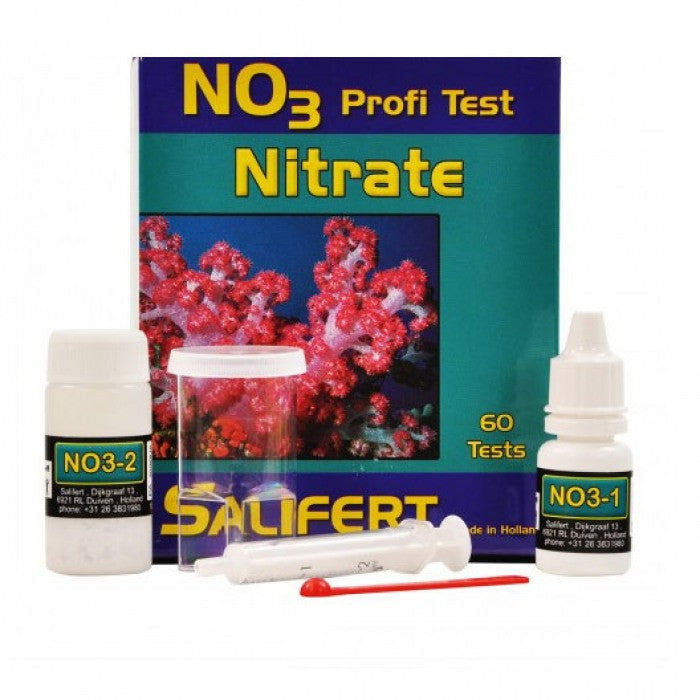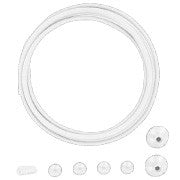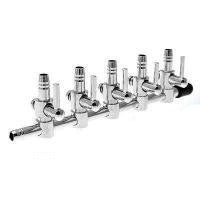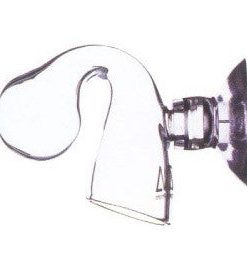Salifert Nitrate (NO3) Profi Test Salifert
$ 24,80 $ 14,88
When there are insufficient areas of a tank which are deprived of oxygen (anaerobic zones) or denitrification is not taking place properly, nitrate will build up. This can also happen in an aquarium where the biological loading on the system is causing an imbalance e.g. if there is excessive livestock for the aquarium volume or over feeding is occurring.
The build up of nitrate can result in unwanted algae growth and the slowing down of coral growth.
The nitrate concentration in a reef aquarium should be lower than 1 mg/L, although fish only aquariums would usually have a higher concentration.
Just as with nitrite, many nitrate test kits are prone to amine interference which can make the levels of nitrate appear much lower than they actually are.
The Salifert test kit does not suffer from such interference and gives accurate and quick results with a total testing time of less than 3 minutes.
The test kit range goes from a very low to a very high nitrate concentration (approx. 0.2 – 100 mg/L as total nitrate).
Sufficient for 50 tests.
This test offers two ranges:
- Low range: 0.2 – 10 mg/L (ppm) as nitrate.
- Medium range: 2 – 100 mg/L (ppm) as nitrate.
Clean test vial and scoop after use. Store this kit in a dry place.
Warning!
KEEP OUT OF REACH OF CHILDREN.
Procedures for both ranges:
- Fill test vial with 1ml of water
- Add one level scoop of NO3-1 powder (compress this powder against the inner side of the powder container).
- Add 1 level scoop of NO3-2 powder and swirl gently (DO NOT SHAKE) for 30 seconds.
- Let it stand for 3 minutes.
- Colour comparison:
Medium Range:
Place the test vial on the white part of the colour chart and compare colours looking from the TOP.
Use diffuse daylight when comparing colours.
If the colour corresponds to a lower value than 10 mg/L nitrate then it might be beter to compare colours as shown for the low range (see below).
Low range:
If the medium range colour comparison procedure gave a reading lower than 10mg/L then you can use the low range procedure. This will increase the accuracy.
The colour for the low range procedure has to be compared by looking through the SIDE of the test vial.
The white part of the colour has to be held firmly against the opposite side of the test vial. Use diffuse daylight when comparing colours.
The colour is, by looking through the side, amplified by approximately 10 fold. For this reason you have to divide the colour chart values by 10. For example 2 will become 0.2 and50 will become 50.
Fast Shipping and Professional Packaging
We can offer a variety of shipping options thanks to our long-term relationship with UPS FedEx DHL. Our warehouse staff will package all goods to our exacting requirements. Prior to shipping, your goods will be thoroughly examined and securely secured. We deliver to thousands of customers every day from all over the world. This is a sign of our determination to be the largest online retailer in the world. Warehouses and distribution centers are located throughout Europe as well as in the USA.
Note: Orders that contain more than one item will be assigned a separate processing time for each item.
Prior to shipment, we examine the items ordered thoroughly before sending the items. Most orders are shipped within 48 hours. The expected delivery time is 3 to 7 days.
Returns
The stock is constantly changing and cannot be fully controlled by us due to the involvement of many different parties, such as the factory and our warehouse. The levels of stock can change at any moment. You may not receive your order once the order has been made.
The policy is 30 days. If it's been longer than 30 days since you made your purchase and we're unable to offer you a complete exchange or refund.
To be eligible for a return your item must be unused and in the same condition as you received it. You must have the item in its original packaging.
Related products
CO2 Accessories
Freshwater Plant
Plant Fertilisation
Plant Fertilisation
Plant Fertilisation
Air Pump Accessories
Substrate
CO2 Accessories
CO2 Accessories
Filter Media
Substrate
Bacteria
Freshwater Plant
Filter Media
Plant Fertilisation
Air Pump Accessories
Uncategorized
CO2 Accessories
Bacteria






































